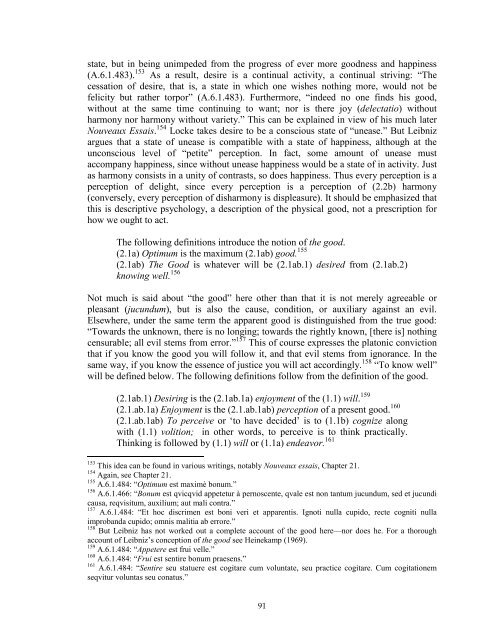Stony Brook University
Stony Brook University
Stony Brook University
You also want an ePaper? Increase the reach of your titles
YUMPU automatically turns print PDFs into web optimized ePapers that Google loves.
state, but in being unimpeded from the progress of ever more goodness and happiness<br />
(A.6.1.483). 153 As a result, desire is a continual activity, a continual striving: “The<br />
cessation of desire, that is, a state in which one wishes nothing more, would not be<br />
felicity but rather torpor” (A.6.1.483). Furthermore, “indeed no one finds his good,<br />
without at the same time continuing to want; nor is there joy (delectatio) without<br />
harmony nor harmony without variety.” This can be explained in view of his much later<br />
Nouveaux Essais. 154 Locke takes desire to be a conscious state of “unease.” But Leibniz<br />
argues that a state of unease is compatible with a state of happiness, although at the<br />
unconscious level of “petite” perception. In fact, some amount of unease must<br />
accompany happiness, since without unease happiness would be a state of in activity. Just<br />
as harmony consists in a unity of contrasts, so does happiness. Thus every perception is a<br />
perception of delight, since every perception is a perception of (2.2b) harmony<br />
(conversely, every perception of disharmony is displeasure). It should be emphasized that<br />
this is descriptive psychology, a description of the physical good, not a prescription for<br />
how we ought to act.<br />
The following definitions introduce the notion of the good.<br />
(2.1a) Optimum is the maximum (2.1ab) good. 155<br />
(2.1ab) The Good is whatever will be (2.1ab.1) desired from (2.1ab.2)<br />
knowing well. 156<br />
Not much is said about “the good” here other than that it is not merely agreeable or<br />
pleasant (jucundum), but is also the cause, condition, or auxiliary against an evil.<br />
Elsewhere, under the same term the apparent good is distinguished from the true good:<br />
“Towards the unknown, there is no longing; towards the rightly known, [there is] nothing<br />
censurable; all evil stems from error.” 157 This of course expresses the platonic conviction<br />
that if you know the good you will follow it, and that evil stems from ignorance. In the<br />
same way, if you know the essence of justice you will act accordingly. 158 “To know well”<br />
will be defined below. The following definitions follow from the definition of the good.<br />
(2.1ab.1) Desiring is the (2.1ab.1a) enjoyment of the (1.1) will. 159<br />
(2.1.ab.1a) Enjoyment is the (2.1.ab.1ab) perception of a present good. 160<br />
(2.1.ab.1ab) To perceive or ‘to have decided’ is to (1.1b) cognize along<br />
with (1.1) volition; in other words, to perceive is to think practically.<br />
Thinking is followed by (1.1) will or (1.1a) endeavor. 161<br />
153 This idea can be found in various writings, notably Nouveaux essais, Chapter 21.<br />
154 Again, see Chapter 21.<br />
155 A.6.1.484: “Optimum est maximè bonum.”<br />
156 A.6.1.466: “Bonum est qvicqvid appetetur à pernoscente, qvale est non tantum jucundum, sed et jucundi<br />
causa, reqvisitum, auxilium; aut mali contra.”<br />
157 A.6.1.484: “Et hoc discrimen est boni veri et apparentis. Ignoti nulla cupido, recte cogniti nulla<br />
improbanda cupido; omnis malitia ab errore.”<br />
158 But Leibniz has not worked out a complete account of the good here—nor does he. For a thorough<br />
account of Leibniz’s conception of the good see Heinekamp (1969).<br />
159 A.6.1.484: “Appetere est frui velle.”<br />
160 A.6.1.484: “Frui est sentire bonum praesens.”<br />
161 A.6.1.484: “Sentire seu statuere est cogitare cum voluntate, seu practice cogitare. Cum cogitationem<br />
seqvitur voluntas seu conatus.”<br />
91
















